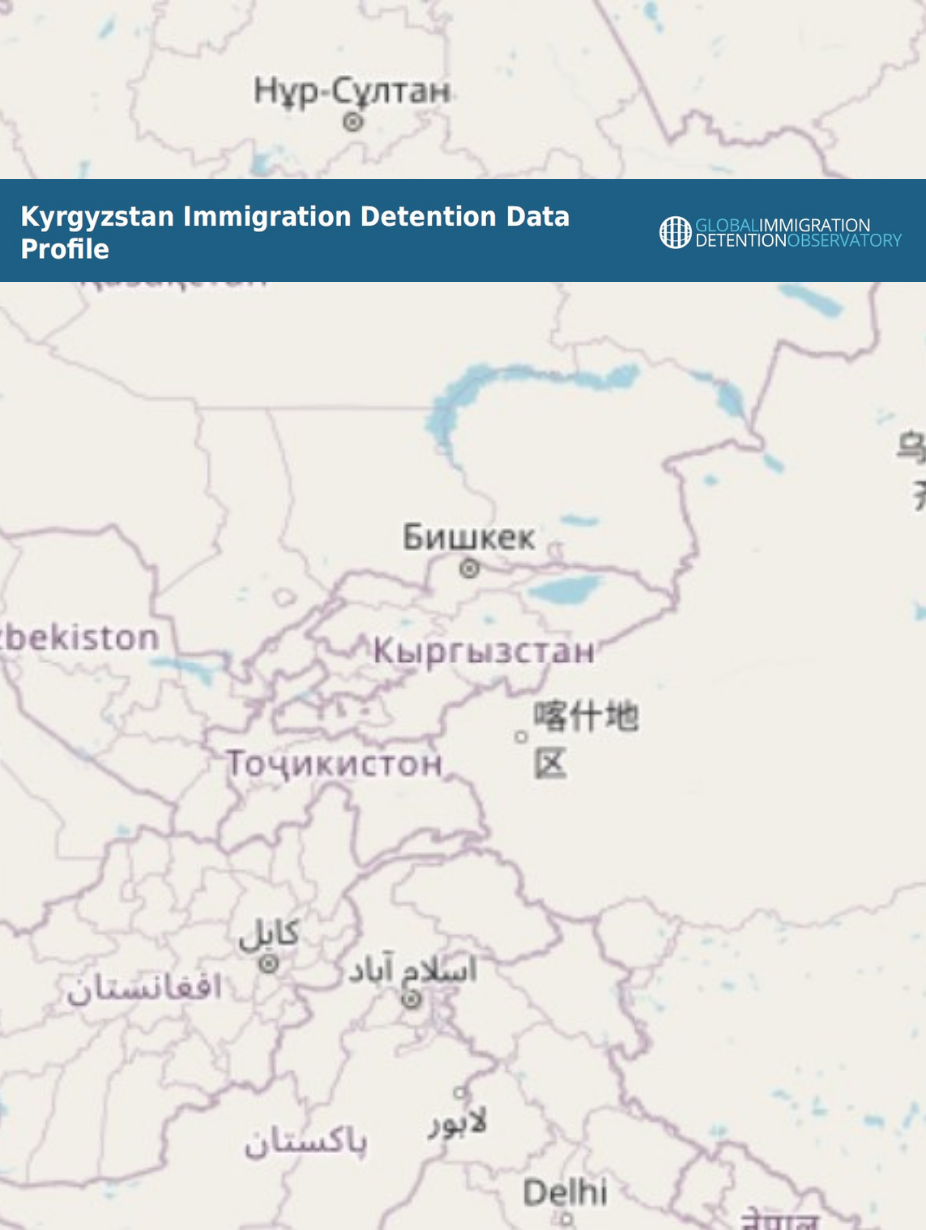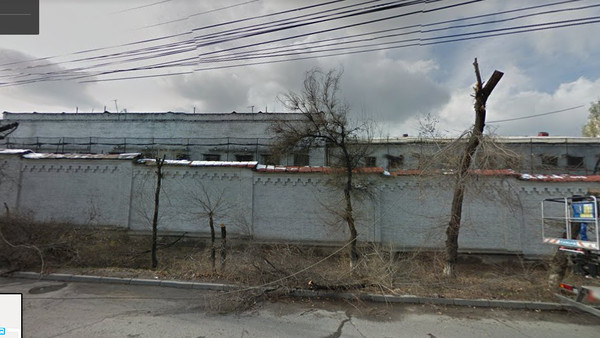In December, UNHCR expressed “grave concern” at the disappearance of an asylum seeker in Kyrgyzstan and his refoulement to his country of origin. Similar incidents have been reported in recent years, with rights observers also decrying the country’s shrinking asylum space. According to UNHCR, on 16/17 October an asylum seeker was arrested by security services […]
17 December 2020 – Kyrgyzstan
Kyrgyzstan considers labour migration to be “part of the national development strategy” with remittances accounting for a substantial part of the country’s economy. Large numbers of Kyrgyz nationals work in countries across Asia and Europe, including in particular Russia (which recorded 959,000 border crossings by Kyrgyz nationals in 2019), Kazakhstan, and Turkey. In 2019, 29.2 […]

Last updated:
DETENTION STATISTICS
DETENTION CAPACITY
ALTERNATIVES TO DETENTION
ADDITIONAL ENFORCEMENT DATA
PRISON DATA
POPULATION DATA
SOCIO-ECONOMIC DATA & POLLS
LEGAL & REGULATORY FRAMEWORK
GROUNDS FOR DETENTION
LENGTH OF DETENTION
DETENTION INSTITUTIONS
PROCEDURAL STANDARDS & SAFEGUARDS
COSTS & OUTSOURCING
COVID-19 DATA
TRANSPARENCY
MONITORING
NATIONAL HUMAN RIGHTS MONITORING BODIES
NATIONAL PREVENTIVE MECHANISMS (OPTIONAL PROTOCOL TO UN CONVENTION AGAINST TORTURE)
NON-GOVERNMENTAL ORGANISATIONS (NGOs)
GOVERNMENTAL MONITORING BODIES
INTERNATIONAL DETENTION MONITORING
INTERNATIONAL TREATIES & TREATY BODIES
International Treaties Ratified
Ratification Year
Observation Date
CTOCTP, Protocol to Prevent, Suppress and Punish Trafficking in Persons, Especially Women and Children
2003
2017
CTOCSP, Protocol against the Smuggling of Migrants by Land, Sea and Air, supplementing the United Nations Convention against Transnational Organized Crime
2003
2017
CAT, Convention against Torture and Other Cruel, Inhuman or Degrading Treatment or Punishment
1997
2017
ICRMW, International Convention on the Protection of the Rights of All Migrant Workers and Members of Their Families
2003
2017
Ratio of relevant international treaties ratified
Ratio: 13/19
Relevant Recommendations or Observations Issued by Treaty Bodies
Recommendation Year
Observation Date
Committee on Migrant Workers
49.The Committee is concerned about reports that Kyrgyz migrant workers and members of their families face discriminatory attitudes and are often targets of hate crimes and xenophobic assaults in the main countries of employment, in particular in the Russian Federation. The Committee is particularly concerned about the lack of protection of Kyrgyz migrant workers abroad from violations of their rights, including arbitrary detention and expulsion and deprivation of liberty in temporary immigration detention centres, and about the lack of protection from recruitment as mercenaries in the Russian Federation. The Committee is also concerned about the lack of information regarding cultural initiatives for the community of Kyrgyz migrant workers, including online courses on the Kyrgyz language and history.
2023
2023
2024
Committee on the Rights of the Child
§ 58. "The Committee recalls its report of the day of general discussion on the rights of all children in the context of migration (2012) and recommends that the State party ensure that children of internal migrant workers are provided with adequate living conditions and immediate access to health care and education irrespective of their residency status."
2014
2014
> UN Special Procedures
> UN Universal Periodic Review
> Global Compact on Refugees (GCR)
REGIONAL HUMAN RIGHTS MECHANISMS
HEALTH CARE PROVISION
HEALTH IMPACTS
COVID-19
Country Updates
Kyrgyzstan considers labour migration to be “part of the national development strategy” with remittances accounting for a substantial part of the country’s economy. Large numbers of Kyrgyz nationals work in countries across Asia and Europe, including in particular Russia (which recorded 959,000 border crossings by Kyrgyz nationals in 2019), Kazakhstan, and Turkey. In 2019, 29.2 percent of the country’s gross domestic product (GDP) was made up of remittances, which places Kyrgyzstan amongst the top five countries with respect to remittances as a share of GDP.
The COVID-19 pandemic, however, has underscored the economic vulnerability of countries that rely on remittances. As previously reported on this platform (see 19 November Uzbekistan update), labour migrants in Russia were almost twice as likely to lose jobs than Russian nationals. According to the Kyrgyz Embassy in Russia, more than half of all Kyrgyz migrants in the country lost their jobs during the pandemic--a fact that has led to a significant drop in remittances and growing concerns for the Kyrgyz economy.
During the early months of the pandemic, when borders temporarily closed and flights were suspended, many Kygyz migrant workers who sought to return home due to job losses found themselves stranded in Russia. When rumours circulated that the border would open in Orenburg Oblast to enable transit through Kazakhstan, an estimated 600 Kyrgyz migrants arrived in the area, where they were forced to wait for several weeks in overcrowded tent camps until buses arrived. By 22 May, those stranded in the area had been returned to Kyrgyzstan--although upon arrival, many were placed in a newly erected quarantine facility in the Semetey Observation facility (formerly the U.S. Ganci Airbase) in Chui Oblast. On 18 May, a group of detained returnees protested their confinement in the facility--and rumours that they would continue to undergo quarantine restrictions while those testing positive for COVID-19 were being released. According to media reports, several returnees attacked doctors and attempted to overturn an ambulance. Following the riot, most of the returnees were permitted to leave and to complete their quarantine period at home.
By 24 August, some 35,469 Kyrgyz migrants had been returned from Russia via charter flights and bus transfers. Nevertheless, the Kyrgyz government faced criticism for its delays in returning nationals stranded in Russia. Kyrgyz authorities argued that employment opportunities remained more favourable in Russia. The Kyrgyz Ambassador to Russia said, “The Russian economy is stronger and more stable than ours. After quarantine, the economic crisis will continue around the world. I advised our countrymen to wait here and not to go anywhere.”
There have been sporadic reports about the use of immigration detention in Kyrgyzstan. In mid-2020, Human Rights Watch raised concerns regarding the detention of an Uzbek asylum seeker (journalist Bobomurod Abdullaev) in the Kyrgyz State Committee for National Security (GKNB) detention facility. Previously, in 2006, UNHCR raised concerns regarding the detention of four Uzbek refugees (fleeing from the unrest and security crackdown in Uzbekistan’s Andijan region) in Osh Pre-Trial Detention Centre. In 2020, this facility was subject to complaints, including accusations of ill-treatment by detainees. The GDP has been unable to confirm whether the centre continues to confine non-nationals for immigration-related reasons, or what steps--if any--authorities have taken to protect detainees during the pandemic.



